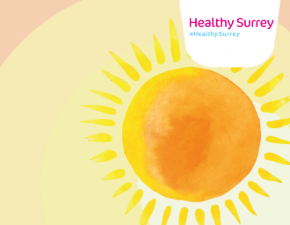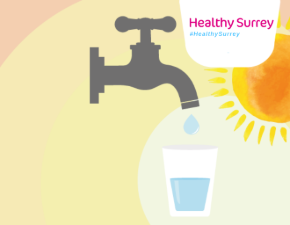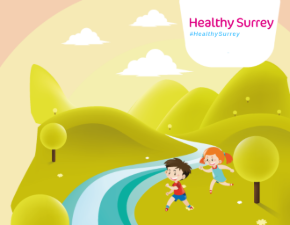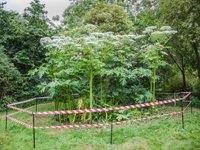Staying safe and well in summer
Our summer health page includes information on how to stay well in a heatwave and also advice on sun, water and food safety, so you can stay safe and healthy all summer

Last updated: 3 June 2024
This page includes information on warm weather safety and advice.
Contents
- Heatwave advice
- Water safety
- What to do in a drought
- Food safety
- Information and advice on oak processionary moths
- Be tick aware
- Advice for those travelling abroad
- Mosquito bite avoidance: advice for travellers
- Keep away from the Giant Hogweed
- 'Thunderstorm asthma'
Heatwave advice
 When we get to the summer, most of us look forward to the hot weather. Some of us can find the heat uncomfortable and even experience sunburn, heat stroke, and bites from insects that proliferate during warmer weather. You can avoid feeling uncomfortable or unwell by making sure you are prepared for summer.
When we get to the summer, most of us look forward to the hot weather. Some of us can find the heat uncomfortable and even experience sunburn, heat stroke, and bites from insects that proliferate during warmer weather. You can avoid feeling uncomfortable or unwell by making sure you are prepared for summer.
Heat affects everybody. For some people, in particular, the very young, the elderly and those who have chronic or severe illness, the health risks can be increased. Prolonged hot weather can exacerbate heart and breathing problems, cause dehydration, increase the risks of fainting or falling and worsen the symptoms of asthma. Everybody can be affected by high temperatures, but there are certain factors that increase an individuals risk during a heatwave. For example, those exposed to the sun for long periods such as outdoor workers and the homeless; and people living in top floor flats.
Some of the signs of heat-related harm include:
- Feeling dizzy, weak or have intense thirst and headache - move to a cool place as soon as possible. Drink some water or diluted fruit juice to rehydrate, avoid excess alcohol.
- Painful muscular spasms (particularly in the legs, arms or abdomen, for example after sustained exercise during very hot weather) - rest immediately in a cool place and drink electrolyte drinks. Most people should start to recover within 30 minutes and if not, they should seek medical help. Call 111 if you feel unusual symptoms, or if symptoms persist.
- Call 999 if a person develops any signs of heatstroke as this is a medical emergency.
 Here are a few tips to keep you cool and well:
Here are a few tips to keep you cool and well:
- Stay hydrated with water
- Keep out of the sun between 11am and 3pm
- If you have to go out cover your head with a hat (preferably with a wide brim) or scarf
- Wear light, loose clothing and choose light coloured clothes
- Apply and re-apply sun screen with a high sun protection factor (SPF) to protect you from harmful ultraviolet B (UVB) and ultraviolet A (UVA) rays. Visit Travel Health Pro's webpage on sun protection for more information.
- Take water with you when travelling
- Limit alcohol as it increases dehydration
 Close curtains on the sunny sides so you avoid the hot sun
Close curtains on the sunny sides so you avoid the hot sun- Open the windows in the evening if safe to do so, when its cool
- Avoid extreme physical exertion, remember to drink lots of water when active
- Make sure babies do not overheat, keep them in light clothing, avoid wrapping them in heavy blankets
- If you have an elderly neighbour check they are ok
- Do not leave pets, children or older people in cars or conservatories which can overheat quickly
- Keep a check on the weather. The Met Office has up to date weather forecasts.
For more information see the Beat the heat leaflet and poster.
NHS Choices provides a lot of helpful advice and further information on how to be prepared during a heatwave, who's most at risk and what to do if someone feels unwell.
Water Safety
 Drowning is among the leading causes of accidental death in the UK with about 400 people drowning every year and many of these tragedies involve children and young people, cutting short lives and devastating families. In addition, a further 200 people take their own life through drowning. The National Water Safety Forum has produced the first UK Drowning Prevention Strategy (2016-26) with the aim of reducing accidental drowning fatalities in the UK by 50% by 2026.
Drowning is among the leading causes of accidental death in the UK with about 400 people drowning every year and many of these tragedies involve children and young people, cutting short lives and devastating families. In addition, a further 200 people take their own life through drowning. The National Water Safety Forum has produced the first UK Drowning Prevention Strategy (2016-26) with the aim of reducing accidental drowning fatalities in the UK by 50% by 2026.
During warm weather, going for a swim can provide much welcomed relief. However, open water swimming can increase the risk of gastrointestinal illnesses, or stomach bugs. If you are going into open water to cool-down, take care and follow the below safety advice to reduce the risk of getting ill.
There are a number of things you should consider including:
- Choosing the location carefully and avoid swimming in water with blue-green algal blooms or scums in freshwaters, check the water quality information.
- Avoid bathing on higher risk days, by checking the pollution risk forecast.
- For those wanting to swim, Surfers Against Sewage always recommend leaving at least 24-48 hours after a pollution or heavy rainfall.
- Covering cuts, scratches or sores with a waterproof plaster before swimming.
- Wearing appropriate protective clothing such as a wetsuit, gloves or protective footwear.
- The conditions at open water sites change constantly. If you are visiting open water spaces there may not be lifeguards in place.
- See the Surrey Fire and Rescue Service's webpage for information about staying safe in Surrey's rivers and lakes.
- Check Swimfo to look up details of a designated bathing water quality by name or location.
Remember to:
- avoid stream water running across the beach
- try to avoid swallowing or splashing water into your mouth
- observe local safety advice
Following the swim, you can minimise the risk of becoming ill by:
- cleaning your hands thoroughly with soap and water ensuring that all wet sand is removed from hands before eating or handling food
- thoroughly cleaning cuts or abrasions using soap and water
- handle your wetsuit with care after use. Rinse it with clean water as soon as is practicable after swimming. Clean with detergent and rinse as advised by the manufacturer. Always wash your hands with soap and water after handling or cleaning your wetsuit. Allow the suit to dry thoroughly before reuse.
If you do become unwell with diarrhoea or any other symptoms, seek medical help and let them know you have been open water swimming. Do not swim again until you have had no diarrhoeal symptoms for at least 48 hours, or for a longer period if advised by a doctor.
Further information:
- Swim healthy - information from GOV.UK
- Open water safety tips - Royal Life Saving Society UK (RLSS UK)
- Call 999 immediately and ask for help. If you are inland ask for the fire service, if you are at the coast ask for the coastguard
- Give an accurate location as possible
- Keep your eye on the person in the water, or where they last were
- Do not enter the water and attempt to rescue someone, and do not get too close to the waters' edge
- Shout to the person in the water, and encourage them to float on their back and breath normally
- Look for lifesaving equipment such as throwlines, floats or rings to throw to the person in the water
- If the person manages to get out of the water, they will need medical attention, even if they seem okay
Ensure you and your family know the 'Safe' code:
- SPOT - spot the dangers
- ADVICE - follow safety signs and advice
- FRIEND - stay close to a friend or family member
- EMERGENCY - shout for help and know the emergency number to call in the country you're in
More water safety tips are available for when you are on holiday, at home or at the beach.
What to do in a drought
 As we encounter more frequent increases in temperature and in times of extended periods of low rainfall, we are more at risk of experiencing drought conditions. We may be asked to reduce unnecessary use of water, for example, by not washing our cars or watering our gardens or filling pools with a hosepipe. Water resources may need to be conserved further, and used only for essential needs such as drinking, cooking, and hygiene practices.
As we encounter more frequent increases in temperature and in times of extended periods of low rainfall, we are more at risk of experiencing drought conditions. We may be asked to reduce unnecessary use of water, for example, by not washing our cars or watering our gardens or filling pools with a hosepipe. Water resources may need to be conserved further, and used only for essential needs such as drinking, cooking, and hygiene practices.
There are several health impacts associated with drought, which relate to dehydration, increase of transmission of infectious diseases and poorer mental health.
There is information about things we can all do to keep well and safe during droughts including keeping informed about restrictions, staying hydrated, maintaining hygiene and looking after your mental health. You can also find out if your eligible to sign up to the water companies Priority Services Register if you need extra support.
Food safety
Foodborne illness tend to increase in summer due to a variety of factors, including warmer temperatures. Stay healthy and safe during warmer months by following the Food Standards Agency advice on food safety and hygiene with information for preparing and cooking food at home, buying and eating food, food poisoning and food safety advice.
Information and advice on oak processionary moths
The caterpillar of the oak processionary moth (Thaumetopoea processionea) lives on oak trees and has been found in the south east of England in 2018, including Surrey. In late spring and summer, the caterpillars have thousands of tiny hairs that can cause itchy rashes, eye problems and sore throats and very occasionally breathing difficulties. This can happen if people or animals touch caterpillars or their nests, or if the hairs are blown into contact with the wind.
The greatest risk period is May to July, but they can be present on old nests and could be blown or touched at any time of year.
For more information and advice, including how to report any sightings to the Forestry Commission please visit the Surrey County Council oak processionary moths information and advice webpage.
If you do come into contact with the larvae or caterpillars by accident, please follow the health advice about dealing with caterpillar hairs on the NHS website.
Be tick aware
Ticks are small spider like creatures that feed on the blood of animals including people. They are found outdoors all year around – in woodland, long grass, some parks, and gardens. Ticks are most active between spring and autumn, but they do not fly or jump. Ticks wait on vegetation and then climb on as their host passes by. Tick bites can sometimes transmit microbes that cause infections such as Lyme Disease which if left untreated can lead to more serious conditions. Since tick bites are not painful, people do not always realise that they have been bitten.
A tiny spider-like creature. It is an arachnid.

Walking on clearly defined paths to avoid brushing against vegetation, using insect repellent, wearing light coloured clothes, and performing regular tick checks. You may not feel the bite that's why it's important to do a check.
It is important to remove ticks safely and as quickly as possible to avoid any infection, by using a pair of fine-tipped tweezers or a tick removal tool.
If you begin to feel unwell with flu-like symptoms or develop a spreading circular red rash (which usually appears within 1 to 4 weeks after being bitten), contact your GP or NHS 111 promptly. Let them know if you were bitten by a tick or have recently spent time outdoors.
Find out more about tick awareness from the UK Health Security Agency poster and leaflet. Share with your family and friends so they too can keep well, safe and enjoy the outdoors.
Video - watch out ticks about
Advice for those travelling abroad
Lots of people will be travelling abroad this year. We are reminding people it is important to check your destination before you travel and be prepared by staying up to date with the latest outbreaks and events. It is important to stay protected so you can enjoy your trip abroad.
As people are travelling more and more outside of the UK, UK Health Security Agency (UKHSA) wants travellers to be aware of the guidance and resources available to them. The Travel Health Pro website, has information on health risks in countries across the world and is a useful one-stop shop for information to help when planning your trip abroad.
Ideally travellers should consult their GP, practice nurse, pharmacist, or travel clinic 4 to 6 weeks before their trip for individual advice, travel vaccines and malaria prevention tablets, if relevant for their destination. Get advice as soon as possible even if you are due to travel soon. It is important to ensure you and your children, are fully up to date with all routine NHS vaccinations before travelling overseas - as well as checking any necessary additional vaccines for the countries and regions you are visiting. Remember, good hand and respiratory hygiene to reduce the risk of infection and limiting spread to other people is also important.
New data from UKHSA shows there is a rise in the number of cases of malaria in England, Wales and Northern Ireland individuals who had travelled abroad in 2023, compared to 2022. The rise is linked to the resurgence of malaria in many countries and an increase in overseas travel following the removal of pandemic restrictions. Overseas travellers, including Hajj pilgrims, are urged to check well in advance to ensure they are up to date and have all necessary vaccinations - being mindful that it can take a few weeks following vaccination for the immunity to take effect.
In countries with insects that spread diseases like dengue, malaria or zika, travellers can protect themselves by using insect repellent, covering exposed skin, and sleeping under a treated bed net where air conditioning is not available. Check out the section on this webpage Mosquito bite avoidance - advice for travellers.
UKHSA and National Travel Health Network and Centre (NaTHNaC) have produced guidance for those travelling abroad to help them reduce potential health risks. The guidance is available in a variety of languages and accessible formats.
If you or members of your group feel unwell during the trip, it is important to seek medical help while abroad. When returning to the UK, if feeling unwell, individuals should promptly seek medical attention and ensure they inform their healthcare provider that they have been travelling recently.
See vaccinations and immunisations page for more information about vaccinations.
Mosquito bite avoidance - advice for travellers
Most of us enjoy travelling, seeing and learning about other parts of the world. By taking sensible precautions we can enjoy our holidays safely. In many countries, mosquito bites can spread diseases like chikungunya, dengue, Japanese encephalitis, malaria, West Nile virus, yellow fever and Zika. They can result in serious illness and some may even be fatal.
- Mosquitoes that spread chikungunya, dengue, West Nile virus, yellow fever and Zika mainly bite during the day and at dusk.
- Mosquitoes that spread malaria mainly bite in the evening and at night.
Avoid insect bites at all times including during the day.
1. What to do before travelling
- Check travel health advice for your destinations at Travel Health Pro
- See your practice nurse, GP, pharmacist or a travel clinic at least 4-6 weeks before travel for appropriate advice
- If you have health problems, are pregnant or planning pregnancy it is important to seek this pre-travel advice 6 to 8 weeks before travel
2. Three ways to avoid mosquito bites
- use the recommended repellent, e.g. with 50% Deet
- use the repellent day and night, indoors and outdoors, on any exposed skin
- cover-up with clothing
- use an insect treated mosquito net when sleeping outdoors or in accommodation without air conditioning
- If you visit a malaria risk country and have a fever (38˚C or more), flu-like symptoms or any unusual symptoms during or after travel you must get urgent medical attention
- Don't wait until you return to the UK if you are unwell; get medical help abroad
- If you are ill after you return, tell your doctor about the trips you took in the past year
For more information visit:
Mosquito bite avoidance: Advice for travellers
Keep away from Giant Hogweed
 The Giant Hogweed (Heracleum Mantegazzianum) was first introduced from the Caucasus to Victorian gardens in the late 19th century. The Giant Hogweed is a tall plant, usually three to five metres with several hundred small white flowers in large umbrella-like flower heads and is closely related to the innocuous cow parsley.
The Giant Hogweed (Heracleum Mantegazzianum) was first introduced from the Caucasus to Victorian gardens in the late 19th century. The Giant Hogweed is a tall plant, usually three to five metres with several hundred small white flowers in large umbrella-like flower heads and is closely related to the innocuous cow parsley.
In the United Kingdom, the Giant Hogweed has become extremely invasive in suitable habitats, such as river and stream banks, railway lines, disused waste land and other damp places. The Botanical Society of Britain and Ireland (BSBI) provide lots of interesting maps and articles about this plant.
Giant Hogweed can pose a serious and significant risk to public health. The sap contains chemicals and toxins which, in the presence of sunlight, can cause a potentially dangerous skin reaction in those who come into contact with it. This can result in burning, itching and blistering. These lesions are slow to heal with the potential of serious scarring persisting for years. The toxins of the Giant Hogweed can be found in the leaves, stems, roots, flowers and seeds. These toxins can cause an acute reaction especially in children. Within 24-48 hours of contact, rashes, burns and blisters may start to appear as well as visible discolouration and dense pigmentation after 3-5 days. Seek medical advice, and do not expose the area to sunlight for a few days.
In the summer months, gardeners, children and those enjoying outdoor activities should be aware of the potential risk of Giant Hogweed. This plant can spread in sweltering heat of the summer months.
If you come into contact with the Giant Hogweed, cover the affected area of skin immediately from sunlight. Then wash the skin with cold water as soon as possible and do not expose the area to sunlight for a few days. If contact is with the eyes or blisters occur or you feel unwell, seek medical advice immediately.
For more information: Giant Hogweed: The Facts - Woodland Trust and BSBI maps
'Thunderstorm asthma'
Thunderstorms are a typical phenomenon during the summer season.
There have been instances where thunderstorm activity has been linked to increases in people reporting symptoms of asthma and seeking medical attention for issues with their breathing. These episodes are termed 'thunderstorm asthma'. We don't fully understand why these events trigger breathing problems and scientific evidence is currently being sought so we get a fuller picture.
However, what is currently known is that there is a link between the air flow within a thunderstorm system and surface wind which blows across grass and plants, picking up pollen grains and fungal spores (tiny biological particles by which fungi reproduce), which are carried on air currents. This may be the reason why there is more pollen in the atmosphere during a thunderstorm.
While everybody may be at risk from thunderstorm asthma, there is some evidence that certain people are at greater risk of experiencing thunderstorm asthma. These include those who have:
- previously been diagnosed with asthma - particularly those whose asthma is poorly controlled or who do not regularly take preventer medication
- asthma, but this has not been formally diagnosed at the time of the thunderstorm asthma episode
- seasonal allergic rhinitis (hay-fever)
Asthma and hay-fever are very common conditions in the UK with statistics from Asthma and Lung UK suggesting that 1 in 11 children and 1 in 12 adults, (equivalent to 5.1 million people) currently receive treatment for asthma in the UK.
As well as keeping an eye on the weather forecast, Asthma and Lung UK advise:
- Keep taking your regular preventer inhaler so you're less likely to get symptoms
- Carry your reliever inhaler with you at all times so you're ready if symptoms do come on
- Keep inhalers in a cool place out of direct sunlight so they continue to work well
- Use a written asthma action plan so you know what to do if a thunderstorm is forecast or triggers symptoms
- Go for regular asthma reviews to check you're on the right medicines for you, and you're taking your inhalers in the best way to get the benefits
- Take your usual hay fever treatments such as a nasal spray and/or antihistamines during your pollen season.